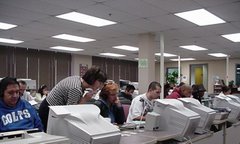People often comment on the quality of my lab staff. They ask me my secret for getting the best and most talented candidates, and my answer is: flexibility. Yes, I work in an ed-tech environment, but I never consider a person’s background in technology as a key factor in whether I should or shouldn’t hire them. I’ve learned that tech skills can be taught. Indeed, they change so often that even the most highly skilled technicians would be at a loss if they didn’t keep up. Instead, I look for a great teacher who is able to effortlessly share their knowledge with students, and someone who is flexible enough to try out new apps and ideas, without a sense of dread. I’ve also built-in my own openness to new ideas. Whenever we’re faced with a changing set of circumstances, such as a new grant that takes us in a different direction, I open the floor to ideas. How should this be approached? What’s the best and most efficient way of developing the educational plan to effectively teach this new subject area? Which apps would make this content easier for students to access?
A simple example is the development of hotlists for subject areas. We had lists of websites. Lots and lots of lists. My specialists said that while the lists were useful, there were several aspects that they found frustrating. One issue was that students had a difficult time accessing the sites, because the URLs were impossible to type correctly. We found that apps such as Tiny URL would solve that problem, though students still had to type out something to get to the site. Another issue was that it was difficult to add to the printed lists, and we ended up throwing out papers when the lists were updated. Our solution was to switch to a web-based list that could be printed (and updated) as needed, but was unfortunately specific to the computers in our labs. Both of these tools worked, but never offered the usability that we really wanted to have. We tried putting the lists on disks, but those too became outdated pretty quickly.
One day I was reading through the blogs, and found a site called Fliamentality which gave us the ability to create hotlists of websites that we could add to a blog site. Suddenly we had the kind of tool that actually worked for giving students and instructors the access to the academic websites they needed, was available to them wherever they had Internet access, and could be updated and shared immediately by accessing one simple web address. A sample of the Fliamentality hotlists can be seen on our AELC Instructor Blog . These can be organized by area, and a simple click on the name would take students exactly where they should be on the site. Although the other methods worked, this method had the flexibility to adapt as new websites became available. Even though the original lists took a lot of effort to put together, this newer system accomplished the same goal, but in more efficient way. Overnight we switched to the hotlists, and our ability to share the websites increased dramatically.
Change is always difficult, especially in education. Educators are always pressed for time, and change requires effort. You have to learn a new application. You have to take what you previously had (which may still be somewhat effective) and change it to the new format. Often it means tossing out the old ideas, and developing a new system from the ground up. It takes a certain amount of courage to move from the old saw ‘if it isn’t broken why fix it?’ Ed-tech is all about change. What is new and exciting today is old news in six months. You don’t need to change constantly, but you do need to assess constantly, and review new apps and ideas with the idea that they can make your program, or classroom, work better.
Subscribe to:
Post Comments (Atom)


No comments:
Post a Comment